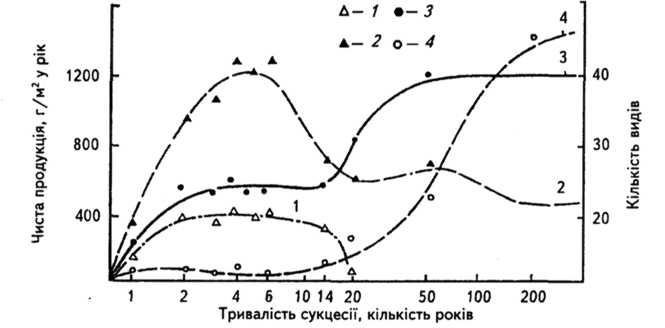
- •Institute of Environmental Safety
- •Term Paper
- •Introduction
- •1. Basic types succession, their characteristics
- •1.1. Succession and there factors
- •1.1.Factors
- •1.2 Types of succession
- •1.2 Synhenetychni and endoekohenetychni succession
- •1.3 Ekzohenetychni and holohenetychni succession
- •1.4 Degradation of succession
- •1.5 Succession in forestry
- •1.6 Autotrophic and heterotrophic succession
- •1.7 The concept of menopause
- •2. The causes of ecological succession and their implications
- •2.1 Changes in primary and secondary succession
- •2.2. General laws Succession Process
- •2.3. Іmpact of human activity
- •Conclusions
- •References
1.6 Autotrophic and heterotrophic succession
There are also autotrophic and heterotrophic succession. The above examples refer to autotrophic succession, since they occur in ecosystems where the central element is vegetation. Since its development related changes heterotrophic components. Such successions potentially immortal, as always replenish energy and matter, produced or recorded in organisms during photosynthesis or chemosynthesis. End they usually klimaksnoyu stage of development of ecosystems.
By heterotrophic succession are those that occur in the substrate where otstutstvuyut live plants (producers) and involved only animals (heterotrophs) or dead plants. This type of succession occurs only as long as there is a ready supply of organic matter, which vary different types of organisms destroyers. With the destruction of organic matter and the release of energy from it suktsessyonnыy series ends, the system breaks down. Thus, this succession by its nature destructive. Examples of heterotrophic succession are taking place, such as the decomposition of dead trees or dead animals. Thus, the decomposition of dead wood there are several stages of change heterotrophs. First on the dead, often weakened wood, settled nasekomыe-koroedы. Then they pereminyayut insects that feed on wood (Xylophagy). These are the larvae of barbel, and other jewel. At the same time reaching changes in fungal populations. They have approximately the following sequence: fungi pioneer (usually wood painted in different colors), mushrooms destructors that are contributing to soft rot and fungi-humifikatory that make some rotten wood in humus. At all stages of succession also present bacteria. Ultimately, the organic matter decomposes in the bulk to the final products, minerals and carbon dioxide. Heterotrophic succession widely implemented during the decomposition of detritus (in the woods, he presented the forest floor). They also occur in the faeces of animals, polluted waters, particularly intense in the biological treatment followed by treatment using activated sludge, rich abundance of organisms.
1.7 The concept of menopause
The concept of climax belongs Frederic Clements (1916), who argued: in any climate zone there is only one true climax - the final stable state of plant grouping which is in equilibrium with the surrounding environment . Its occurrence are all successions whether it started with sand dunes, overgrown fallow or even rate, which gradually turns into upland communities. Tensli (1939) and his associates denied Clements and talked about poly-climax, while arguing that the climax in this area can be determined by one or more factors: climate, soil conditions, topography, fire and more. Therefore in one climatic zone, without a doubt, there may be a number of specific types of menopause (eg, beech forests, chornovilshnyaky Transcarpathia), whose composition is fairly constant over time (the last two centuries).
Appearance climax biocenosis explained first change the prevailing population-based competitive interaction that leads to the gradual formation of stable groups that meet existing abiotic environmental conditions prevailing during the historical period. This chain of biomes, which succeed each other, called seral number, each temporal element which is a certain stage of formation of the final klimaksovoho group (Fig .3).

Fig. 3. Changes in species diversity and net primary production in the succession, leading to a climax mixed forest of pine and oak 1 - herbal plants, 2 - shrubs, 3 - pine, 4 - oak.
Succession of vegetation - a sequence of serial changes (temporarily existing) plant communities in a particular place stay after the withdrawal of a particular ecosystem from the state of dynamic equilibrium. As a result of succession in a particular place stay restores the original plant community, called geo-botanists roots. The native plant community is stable in these climates is not changed. In this particular ecosystem returns to its original state and remains there until you change the climate, topography, hydrological regime, yet again will be a fire or some other disaster happens. Again, begin a new succession that either lead to the restoration of the original community or not.
If passed the fire, cut down the forest, meadow or plain dis-plowed and then stoned, then most likely, succession is complete restoration of the indigenous community, as well as the original will be in a state of relative equilibrium with the environment. However, if climate change, dropped or increased groundwater level, the community of plants derived from a state of equilibrium, in the process of succession will not recover the same. It is fundamental, sohlasuyas new environmental conditions, but other than the original indigenous community.
There is a hypothesis suggested that in the present conditions in areas with unstable monsoon indigenous communities do not have time to form. Significant vegetation to climate movement taking place faster than going suktsessyonnыy row. In the modern era of radical climate vegetation does not have time to form, and vegetation dominated by serial community.
